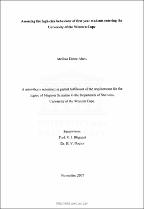| dc.description.abstract | Globally, new HIV infections are heavily concentrated among the youth, i.e., persons aged 15-24 years old (UNAIDS, 2006b). In South Africa, the estimated national HIV prevalence was 10.4% among the youth in 2006 (Dorrington et a|.2006). The 2005-2006 national South African HIV rates ranged from 31.8o/oto39.3% among female youth and from 7.5oh to 10.1o/o among male youth (Dorrington et al. 2006; Pettifor et al. 2004; Shisana et al. 2005). UNAIDS (2006) stated that the future course of the HIV epidemic
hinges on the high-risk behaviours the youth adept or maintain. The motivation for the study is to assess the high-risk behaviours that contribute to the spread of HIV and AIDS among the youth. The most influential high-risk behaviours that contribute to the spread of HIV and AIDS are unprotected sexual intercourse and having more than one sexual partner (Nattrass, 2004, Pettifor et al. 2004; Shisana et al. 2005;
UYF & HSRC, 2005). Those who are in violent relationships, fear the threat of violence, which prevents them from insisting on condom use and this increases the risk of HIV infection (MacPhail & Campbell, 2001). Factors that leave the youth unable to set boundaries on when they want to have sex, what type of sex, or the use of contraception increase the risk of HIV infection. These factors include transactional sex, young age at first sex, cigarette smoking, alcohol use, drug use and suicidal behaviour (Aitken, 2005; Basile et al. 2006; Flisher et al. 1993c; Kauftnan & Stavrou, 2002; Pettifor et al. 2004; Shisana et aI.2005\. The population for this study included all full time first year students who registered at UWC for the first time in 2006 that attended the orientation week. A stratified, sequential random sample was drawn from the students attending the orientation. The Science Faculty Research Committee of UWC gave the consent to undertake the study. Informed
consent was obtained from the 796 respondents and anonymity of their participation was ensured. The measuring instrument was a self-administered questionnaire. SAS package (SAS Institute Inc. 2004-2005) was used to clean the data and to do the analyses. Frequencies and percentages were provided for nominal and medians were provided for ratio scales. Rao-Scott Chi-square test was used to test the bivariate analysis between the high-risk behaviours. Multivariate logistic regression models were used to provide a clearer perspective on the effects of high-risk behaviours on non-condom use at last sex | en_US |

